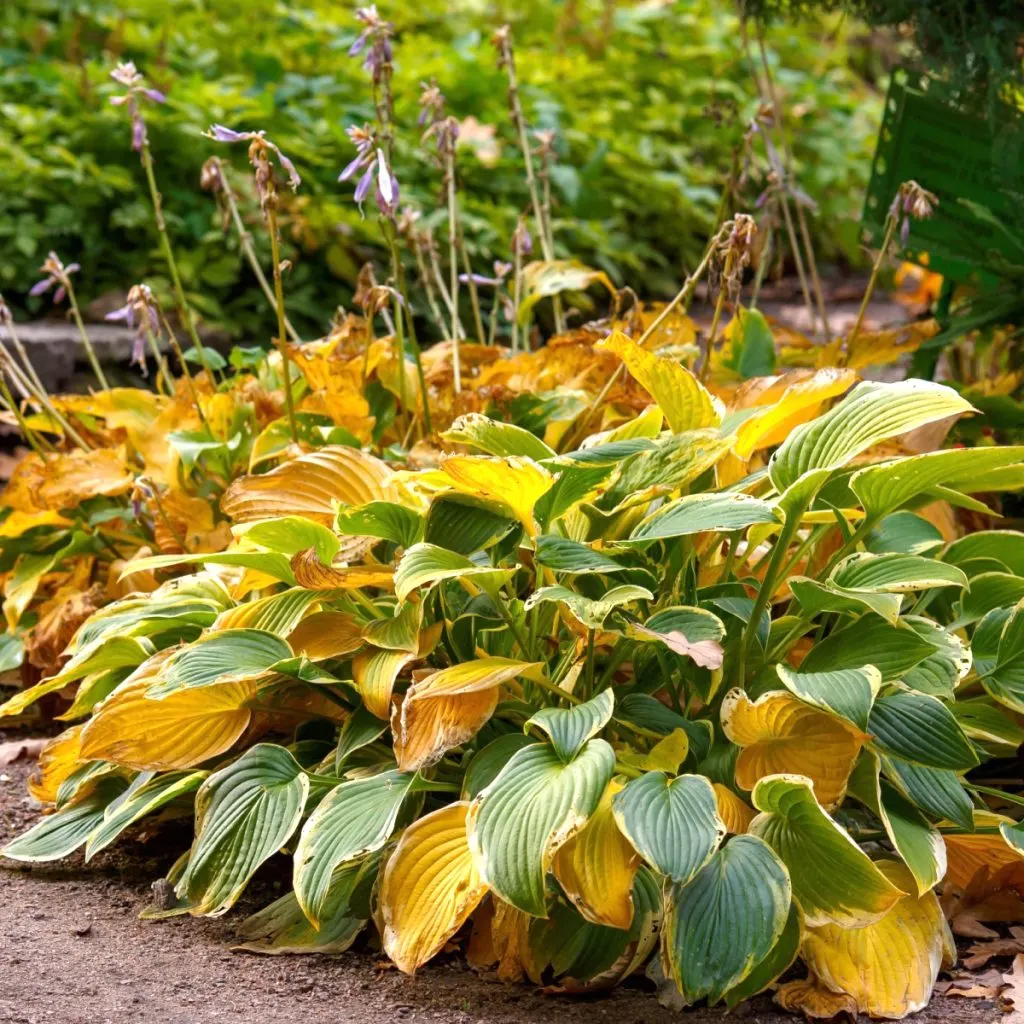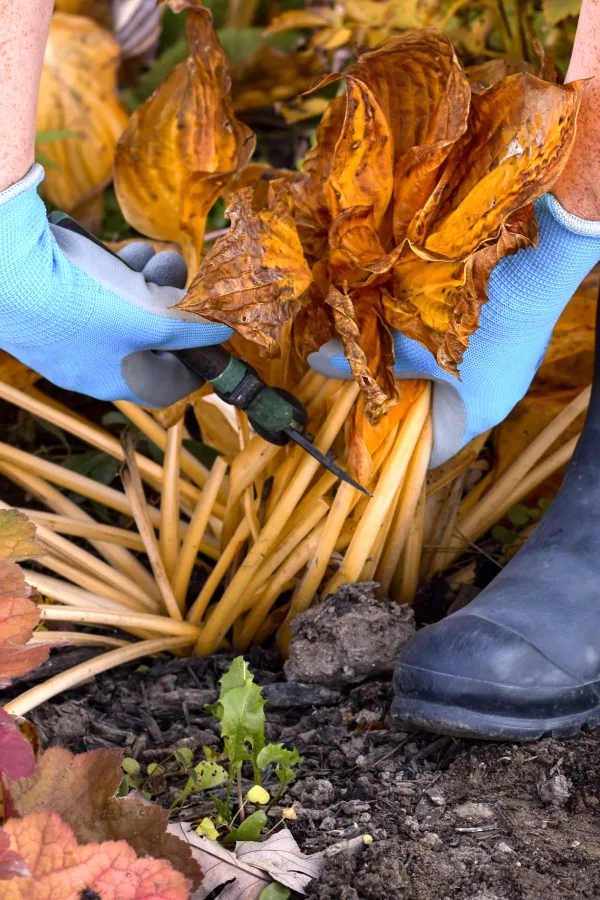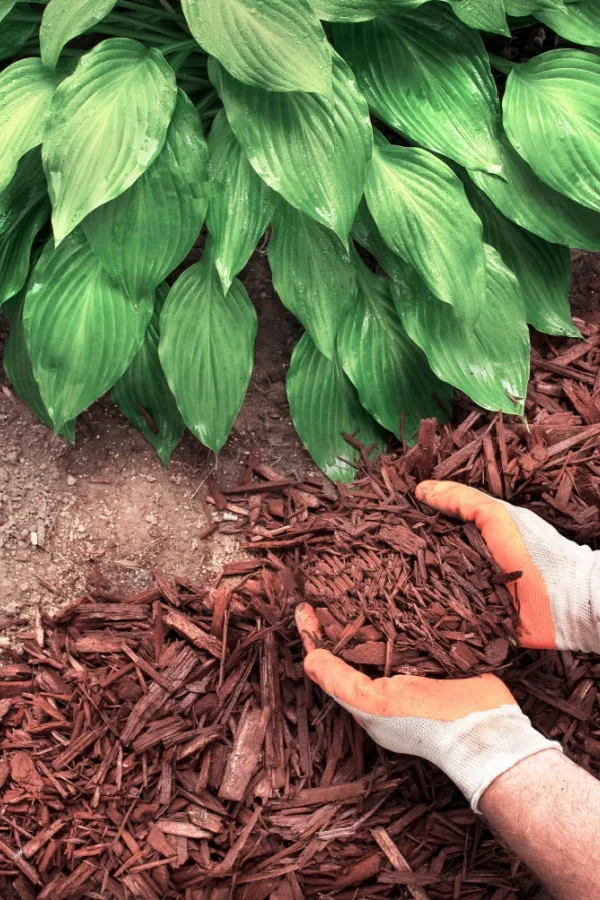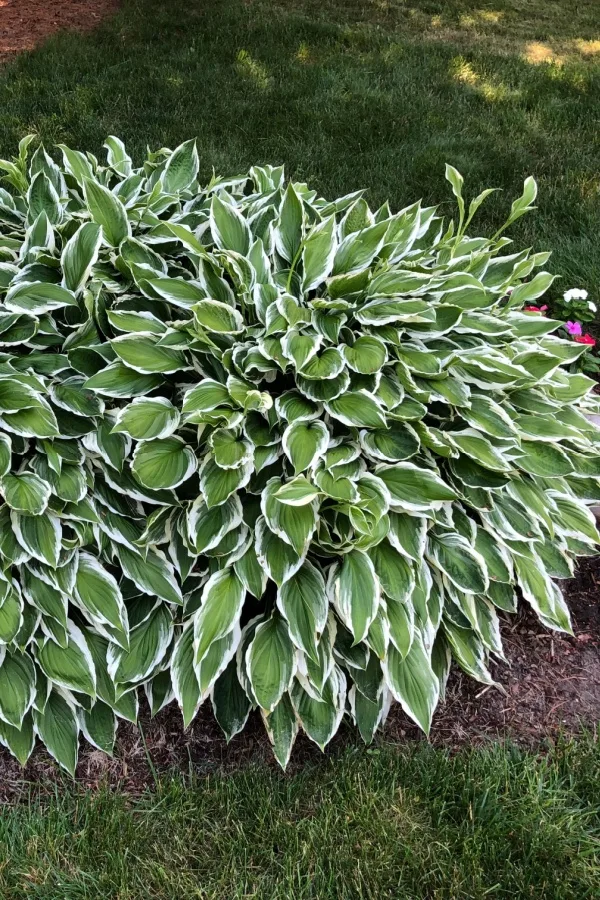Wondering what to do with your hostas once the weather starts to cool down in the fall to get them ready for winter and next year?
By late summer and early fall, most hostas have seen better days. As the weather cools down, the plants are quick to fade. Their foliage and flower stalks end up brown, wilted, and are often riddled with pest damage as well.
Unfortunately, what was once such a beautiful sight in your flowerbeds begins to become more of an eyesore – which is exactly why fall is the perfect time to perform a little TLC on your hostas. Not only will it help to clean up your flowerbeds and landscape, but it can also set the stage for healthy plants in the spring.

In addition, fall also happens to be the perfect time to divide or relocate overgrown plants. Dividing not only helps your plants stay healthy, it also is a great way to produce brand new hosta plants. And best of all, for free by using the plants already established on your property!
One thing is for sure – as you will see below – the care you give plants late in the growing season can make a huge difference in their health, growth and performance next spring and summer!
What To Do With Hostas In The Fall
Step 1 – Removing Dying Foliage
One of the most important things you can do for your hosta plants in the fall is to cut all of their foliage back. This includes not just the spent blooms stems but also all of their browning and decaying leaves.
As the plants start to weaken late in the season, insects and other pests often take over. The large foliage becomes riddled with holes and rips. Besides simply looking quite unsightly, if left, the dying leaves also becomes a harbor for overwintering insects and disease.
This is exactly why you want to cut back all that tattered growth. Since hostas are hardy perennials, they can handle being trimmed back at any point during the year with no ill effects. In fact, doing so during the summer months will actually prompt the plants to push out new growth to replace the old. But in the fall, it helps them to prepare for winter.

Cutting back hosta foliage is simple to do. Just take a pair of sharp, clean pruners and cut a few inches above the base of the plant. Leaving a few inches of stems behind will make mulching and dividing the plants much easier than fully removing the leaves.
Any foliage that is free of disease or insects can be cut up and tossed into your home compost bin. Now it’s time to either dig up and divide overgrown plants – or simply mulch them to prepare them for winter.
Mulching Hostas Before Winter – What To Do With Hostas In The Fall
If your hostas are of small to average size, all that is needed after cutting them back is to add a protective layer of mulch. Even though they are hardy perennials, hostas benefit greatly from a fall mulching.
During the winter months, there is often a lot of thawing and refreezing of the ground. These fluctuations in temperatures can weaken plants or even kill them if it is severe enough. Adding mulch helps to protect against this by insulating the soil, which helps avoid sudden freezing and thawing.

In addition, mulch also stops competing weed seeds from growing. Unwanted weed seeds can land on bare soil via the wind, surrounding plants, or even animals during the late fall and winter months. But with mulch already in place, they will be unable to germinate when the temperatures warm up in the spring.
How To Mulch Hostas In The Fall
To mulch plants, first add a couple of inches of compost around the base of each plant. This will not only insulate plants, but also provide them with extra power and energy when spring arrives.
Next, add a three to four inch layer of mulch on top and all around each plant. Untreated wood shavings, pine bark, needles, shredded leaves or straw all make excellent choices. Product Link: 100% Natural Cedar Shavings
Beyond adding compost, it’s important not to fertilize hosta plants in the fall. This can encourage an excess of new growth to appear. Growth that can expend energy from the plant and put it at a higher risk of freezing out. See: When & How To Fertilize Hosta Plants
Dividing And Splitting Overgrown Plants – What To Do With Hostas In The Fall
If your hosta plants have overgrown their location, fall is the perfect time to divide and split the plants to keep them healthy – and your flowerbeds neat and tidy. It’s also a great way to create brand new plants without spending a dime!
Old, overgrown hostas end up with root structures that are overcrowded. This results in plants that struggle to absorb nutrients as well as moisture from the soil. In the end, plants with overgrown root structures are weaker, more susceptible to pests and disease, and that struggle to produce blooms.

To prevent this from happening, it’s always best to divide and split your hosta plants every 3 to 5 years. Since hostas are extremely hardy plants, they can easily take dividing without any issues.
While you can divide hostas at any time during the growing season, late summer or early fall is the best time. This is because it allows the roots time to establish before winter hits. Then once spring arrives, the plants are ready to grow!
How To Divide Hosta Plants In The Fall
After cutting back the foliage, take a shovel or spade and dig an edge around the perimeter of the plant. Next, dig down a few inches deeper until you can lift the roots out of the ground.
If the roots are too large to take as one piece, it’s best to divide and split the plant before lifting. Don’t worry if you end up cutting a few roots in the process – hostas are quite durable and will recover with ease after transplanting.
Once the plant is out of the ground, turn the root mass upside down. This is great for allowing you to see and access the roots more easily. Now it’s time to cut the root mass into equal, smaller pieces. The size of each piece will dictate how large the new plants will be next year.

Replanting The Divisions – Hostas In The Fall
Get the new transplants into their new location as soon as possible after dividing plants. This will give the hostas the best chance of establishing before winter arrives.
Create a hole that is one and a half times bigger than the size of the new root mass. In the hole, mix in a few inches of compost and soil. Add the hosta division so that the crown of the roots is level with the ground surface. Backfill with additional soil and water well.
Make sure to mulch the new plant just like you would for established plants. Don’t be surprised if you start to see a little bit of new growth if you transplant early enough in the fall. This small amount of new growth will quickly die back with the first frost – and will not harm the plant in the lease.
Here’s to using the fall months to prepare your hosta plants for anything winter can throw at them – and to help them stay healthy, energized, and ready for plenty of new growth in the spring! And once spring rolls around, be sure to circle back and see: Spring Hosta Care – 3 Things You Should Be Doing For Hostas Now!
Simple Garden Life
Follow Our Facebook Page For Even More Great Tips! Simple Garden Life Facebook Page
Simple Garden Life is a website dedicated to keeping gardening fun, simple and enjoyable! We publish two new articles each week along with a new garden podcast episode every two weeks. This article may contain affiliate links.
